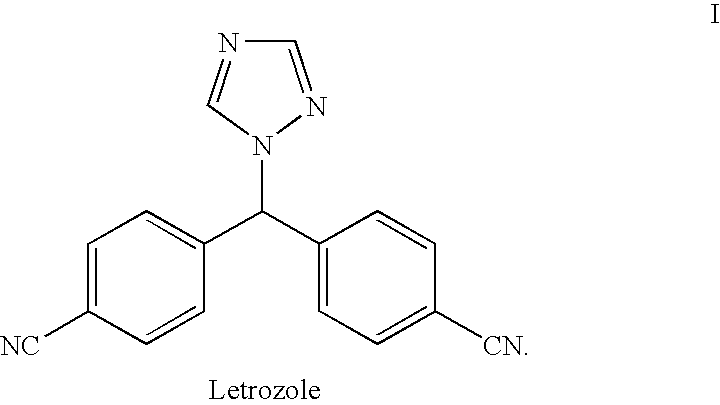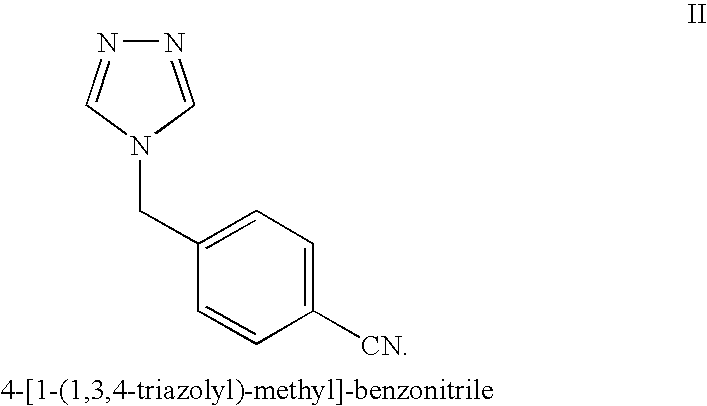Letrozole production process
a production process and technology of letrozole, applied in the field of letrozole production process, can solve the problems of reducing estrogen production, significantly lowering serum estrogen, and being impractical on an industrial scal
- Summary
- Abstract
- Description
- Claims
- Application Information
AI Technical Summary
Problems solved by technology
Method used
Image
Examples
example 1
[0063] This example demonstrates a method for preparing bromo-bis-(4-cyanophenyl)-methane.
[0064] A three-necked round-bottom flask equipped with a mechanical stirrer, a nitrogen inlet and a Dean Stark apparatus was charged with bis-(4-cyanophenyl)-methanol (60 g, 0.256 mole) and toluene (360 ml) and the reaction mixture was heated to 60° C. HBr (48%, 54 ml, 1.8 eq.) was added in one portion and the reaction mixture was refluxed for two hours, during which time water was removed by azeotropic distillation.
[0065] The reaction mixture was cooled to 70° C., water was added (250 ml), and stirring was maintained for 5 minutes. The two resulting layers were separated, the aqueous phase was washed with toluene (50 ml), and the organic layers were combined and washed with an aqueous solution of 5% potassium carbonate (200 ml), then with water (250 ml). Toluene was distilled off under reduced pressure (about 290 ml) and the solution was cooled to 40° C. Hexane was added (240 ml) and the mix...
example 2
[0066] This example demonstrates a method of preparing letrozole from bromo-bis-(4-cyanophenyl)-methane.
[0067] A round bottomed flask equipped with a thermometer, a mechanical stirring device and a nitrogen inlet tube was charged with triazole (29 g, 0.42 mole) and bromo-bis-(4-cyanophenyl)-methane (50 g, 0.168 mole). DMF (200 ml) and toluene (300 ml) were added, and the temperature was raised to 60° C. Potassium carbonate was added (23.2 g, 0.167 mole) and the temperature was raised to 80° C. under a nitrogen atmosphere and mixing was maintained at this temperature for about 1.5 hours. The reaction progress was checked by HPLC. After cooling to room temperature, acetic acid (20 ml) was added.
[0068] DMF (100 ml) and water (490 ml) were added to the reaction mixture to form a suspension (two liquid phases and a solid phase). After heating the suspension to 30° C. the resulting mixture was allowed to cool to room temperature. The resulting crystalline solid was washed with water (15...
example 3
[0069] This example demonstrates a method of preparing chloro-bis-(4-cyanophenyl)-methane.
[0070] A three-necked round-bottom flask equipped with a mechanical stirrer, a nitrogen inlet and a reflux condenser was charged with toluene (240 ml) and zinc chloride (34 g, 2 eq.). The mixture was stirred at 40° C. while HCl (37%, 60 ml, 5.64 eq.) was added in one portion, followed by the addition of bis-(4-cyanophenyl)-methanol (30 g, 0.128 mole). The reaction mixture was heated to 65° C. for 4 hours. Next, the reaction mixture was cooled to room temperature, water was added (60 ml), and stirring was maintained for 5 minutes. The two layers were separated and the organic phase was washed with an aqueous solution of 2.5% sodium carbonate (120 ml), then with water (60 ml). Toluene was distilled off under reduced pressure (about 180 ml) and the solution was cooled to 40° C. Hexane was added (120 ml) and the mixture was cooled to room temperature and stirring was maintained for about 0.5 hour....
PUM
| Property | Measurement | Unit |
|---|---|---|
| temperature | aaaaa | aaaaa |
| temperature | aaaaa | aaaaa |
| temperature | aaaaa | aaaaa |
Abstract
Description
Claims
Application Information
 Login to View More
Login to View More - R&D
- Intellectual Property
- Life Sciences
- Materials
- Tech Scout
- Unparalleled Data Quality
- Higher Quality Content
- 60% Fewer Hallucinations
Browse by: Latest US Patents, China's latest patents, Technical Efficacy Thesaurus, Application Domain, Technology Topic, Popular Technical Reports.
© 2025 PatSnap. All rights reserved.Legal|Privacy policy|Modern Slavery Act Transparency Statement|Sitemap|About US| Contact US: help@patsnap.com



